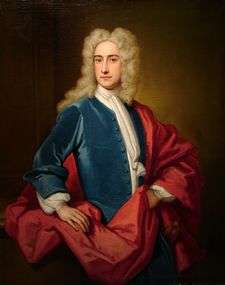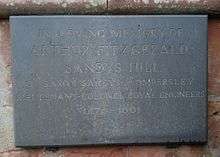Baron Sandys





Baron Sandys (/ˈsændz/) is a title that has been created three times, once in the Peerage of England, once in the Peerage of Great Britain and once in the Peerage of the United Kingdom.
The first creation, as Baron Sandys, of The Vyne, was in the Peerage of England in 1523 for William Sandys, the favourite of King Henry VIII. It passed through several generations of his descendants until it fell into abeyance circa 1683 at the death of the eighth Baron, in which state it has remained since.
The second creation, as Baron Sandys, of Ombersley in the County of Worcester[1] was in the Peerage of Great Britain in 1743 for Samuel Sandys, the former Chancellor of the Exchequer. This title became extinct on the death of his son Edwin, the second Baron, in 1797. The family estates were inherited by Edwin's niece Mary Hill, Marchioness of Downshire, widow of Arthur Hill, 2nd Marquess of Downshire.
The third creation, again as Baron Sandys, of Ombersley in the County of Worcester was in the Peerage of the United Kingdom in 1802 for Mary Hill, Marchioness of Downshire, widow of Arthur Hill, 2nd Marquess of Downshire.
The barony was created with remainder to her younger sons Lord Arthur Moyses William Hill, Lord Marcus Hill, Lord Augustus Hill and Lord George Hill successively, and failing them to her eldest son Arthur Blundell Hill, 3rd Marquess of Downshire.
She was succeeded according to the special remainder by her second son Lord Arthur Moyses William, the second Baron. He was a Lieutenant-General in the Army and also represented County Down in the House of Commons. He never married and was succeeded by his next brother, the third Baron. He sat as Member of Parliament for Newry and Evesham. In 1861 Lord Sandys assumed by Royal licence the surname of Sandys in lieu of Hill. This line of the family failed on the death of his younger son, the fifth Baron, in 1904. The late Baron was succeeded by his second cousin once removed, the sixth Baron. He was the grandson of Lord George Hill, fifth son of the first Baroness.
The sixth baron's son, the seventh Baron, succeeded in 1961. Lord Sandys notably served as Captain of the Yeomen of the Guard between 1979 and 1983 in the Conservative administration of Margaret Thatcher. However, he lost his seat in the House of Lords after the passing of the House of Lords Act of 1999. He died on 11 February 2013[2] and was succeeded in the peerage, under the terms of the special remainder, by the ninth Marquess of Downshire.
The family seat is Ombersley Court in Ombersley near Droitwich in Worcestershire. The traditional burial place of the family is the Sandys Mausoleum in the churchyard of St Andrew, Ombersley. When St Andrew's Church was built in its current form between 1825 and 1829, the chancel of the old church was adapted for use as mausoleum for the Sandys family, who were lords of the manor.[3]
Barons Sandys, first creation (1523)
- William Sandys, 1st Baron Sandys (c. 1470–1540)
- Thomas Sandys, 2nd Baron Sandys (d. 1560)
- William Sandys, 3rd Baron Sandys (d. 1623)
- William Sandys, 4th Baron Sandys (d. 1629)
- Elizabeth Sandys, 5th Baroness Sandys (d. c. 1645)
- William Sandys, 6th Baron Sandys (c. 1626–1668)
- Henry Sandys, 7th Baron Sandys (d. c.1680)
Barons Sandys, second creation (1743)
- Samuel Sandys, 1st Baron Sandys (1695–1770)
- Edwin Sandys, 2nd Baron Sandys (1726–1797)
Barons Sandys, third creation (1802)
- Mary Hill, Marchioness of Downshire, Baroness Sandys (1774–1836)
- Arthur Moyses William Hill, 2nd Baron Sandys (1793–1860)
- (Arthur) Marcus Cecil Sandys, 3rd Baron Sandys (1798–1863)
- Augustus Frederick Arthur Sandys, 4th Baron Sandys (1840–1904)
- Michael Edwin Sandys Sandys, 5th Baron Sandys (1855–1948)
- Arthur Fitzgerald Sandys Hill, 6th Baron Sandys (1876–1961)
- Richard Michael Oliver Hill, 7th Baron Sandys (1931–2013)
- Arthur Francis Nicholas Wills Hill, 8th Baron Sandys, 9th Marquess of Downshire (b. 1959)
See also
References
| Wikimedia Commons has media related to Baron Sandys. |
- ↑ The London Gazette: no. 8286. p. 3. 20 December 1743. Retrieved 2007-11-16.
- ↑ "Telegraph Announcements - Sandys". The Daily Telegraph. London. Retrieved 27 February 2013.
- ↑ Sandys Mausoleum
- Kidd, Charles, Williamson, David (editors). Debrett's Peerage and Baronetage (1990 edition). New York: St Martin's Press, 1990.
- Leigh Rayment's Peerage Pages